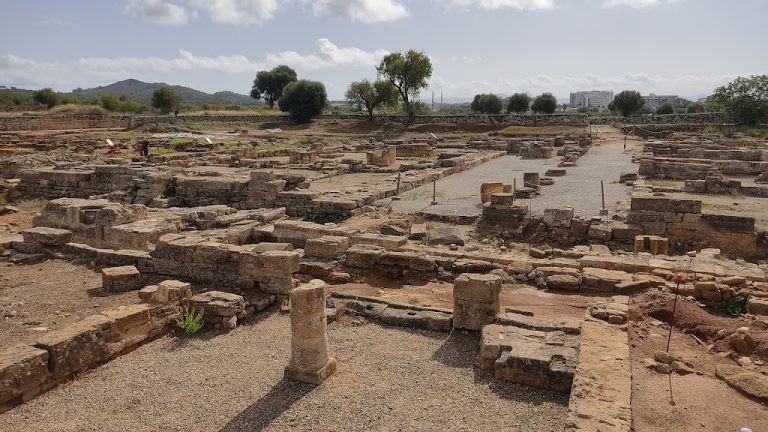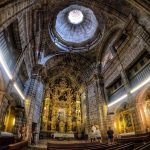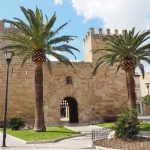Table of Contents
Nestled between the sweeping bays of Pollensa and Alcudia lies an ancient treasure – the ruins of Pollentia. Once a thriving Roman city, these remnants provide a glimpse into Mallorca’s past.
Founded in 123 BC, Pollentia bears witness to over two thousand years of history. Though only partially excavated, the site offers intriguing insights into Roman civilisation.
Get exclusive online discounts on all kinds of Majorca trips & activities
Its well-preserved theatre, forum, and houses conjure images of a long-lost world. This article delves into the history, architecture, exhibits and visitor experience of Pollentia.
Historical Background
The Roman presence in Mallorca began in 123 BC with the arrival of the consul Quintus Caecilius Metellus. During the conquest of the Balearic Islands, Metellus established Pollentia as a military camp or castra.
Situated between two bays, the location afforded strategic advantages. Over the next decades, the settlement developed into a thriving town.
Buildings sprung up amongst grids of streets, transforming the camp into a monumental urban hub. Fires and invasions took their toll in later centuries, but Pollentia remained occupied until at least the 5th century AD.
Successive generations built over the crumbling ruins until they were rediscovered in the 17th century.
Modern archaeological work began in earnest in 1923, meticulously revealing Pollentia’s buried treasures. The excavation continues today through local archaeological institutions.
Their efforts allow visitors to walk streets that knew the tread of Roman feet.
Architecture and Design
Pollentia provides a fascinating look into Roman town planning. Three key areas are open to the public – the theatre, forum and houses of La Portella. These sites showcase features that characterised Roman architecture.
Buildings centred around courtyards with grand facades facing the street. Decorative columns, arches and pavements adorned public spaces. Complex hydraulic systems delivered water throughout the town.
The theatre stands as one of Pollentia’s most striking monuments. Though worn by time, its grassy tiers could seat over a thousand spectators.
The forum served as the administrative and religious heart featuring temples, shops and government buildings.
Nearby houses give insight into daily domestic life with bedrooms, kitchens and latrines. Their remains hint at a prosperous past filled with frescoes, mosaics and marble.
Exhibits and Collections
The archaeological museum in Alcudia complements the sprawling ruins with its collection of artefacts.
Statues, coins, glassware and amphorae shed light on Pollentia’s cultural influences and commercial networks. Recreated cityscapes, artistic impressions and information panels serve to further bring the ruins to life.
Most compelling of all is the ability to explore the remains first-hand over 15 – 20 hectares. Unlike many historical sites, visitors can touch columns, climb stairs and discover foundations at their leisure.
QR codes link to additional details including models. Special guided tours may be available through the museum for those wanting deeper insight.
Visitor Experience
Wandering through the ruins of Pollentia is an atmospheric experience, heightened by birdsong and dappled light. One can easily lose track of time whilst uncovering layer upon layer of history.
The initial ruins soon open up into a sprawling landscape with the theatre located further afield. Comfortable shoes are a must whilst meandering down stony paths. Tree cover provides some reprieve as the summer sun beats down.
Whilst some imagination is required, informative signs allow you to piece together remnants into a grander vision. Witnessing the contrast of crumbling rubble against the Tramuntana mountains never fails to inspire awe.
The ability to freely explore makes it all the more engaging for visitors. Regular special events, theatre performances or historical reenactments serve to further transport you back through the ages.
Accessibility and Practical Information
The ruins of Pollentia are easily accessed on foot from Central Alcudia. There is abundant free parking for those arriving by car, including spaces for disabled drivers.
Guided tours may require booking in advance by contacting the archaeological museum.
Opening days and hours vary by season:
Summer (June 15 – September 15)
Tuesday – Sunday: 9:30 am – 8:30 pm
Winter
Tuesday – Friday: 10 am – 4 pm
Saturday & Sunday: 10 am – 2 pm
Entry costs €4 per person with concessions available. Tickets include same-day access to the archaeological museum.
Be sure to pack water, a hat and sunscreen before traversing the expansive ruins. There is wheelchair access to most areas.
Local Surroundings and Attractions
Pollentia provides the perfect introduction to Alcudia’s rich history. Entry tickets include the archaeological museum, housed within the Gothic stone walls nearby.
Pretty plazas, medieval architecture and restaurants await in the old town. Be sure to sample ensaimadas, the iconic Mallorcan pastry.
Nature lovers will appreciate the beauty of Alcudia’s beaches, including sweeping bays and coves.
For those with transport, the historic towns of Pollensa and Port de Pollensa are a short drive away.
The UNESCO site of Alcudia’s medieval walls also warrants a visit.
A wealth of markets, waterparks, watersports and hiking trails round out the options.
Personal Reflection
I always leap at opportunities to walk amongst ancient ruins. Yet strolling along Pollentia’s paved streets carried a unique magic – a portal into Mallorca’s rich past.
Despite the summer heat, I easily lost hours uncovering layer upon layer of history. Closing my eyes, I could readily imagine the chatter of the marketplace or crowds pouring into the theatre.
The ruins carry a beauty in their rawness, enlivened by wildflowers and songbirds. Pollentia deserves equal billing alongside Mallorca’s glorious beaches.
No trip to Alcudia is complete without stepping back 2,000 years amongst the lively ghosts of Romans past.
Conclusion
The sprawling ruins of ancient Pollentia offer an enthralling glimpse into Roman Mallorca. Well-preserved features transport you back through the ages with history springing to life.
The visitor experience is enriched by interactive elements, artefacts and guided tours. Beyond the ruins, Alcudia charms with its beaches, markets and medieval beauty.
Pollentia merits a visit to witness millennia of Mediterranean history first-hand. Lose yourself for an afternoon ambling down its stone-paved streets.
Location
Click to show map!

Mark Kaye is a travel writer and content creator living in Majorca, Spain. Originally from the UK, Mark moved to the island and quickly fell in love with Majorcan culture, food, and scenic landscapes. When he’s not busy writing detailed guides about Majorca’s top tourist attractions and hidden local gems, you can find him out exploring coastal trails or wandering the streets of Palma’s Old Town in search of his next great restaurant discovery.








